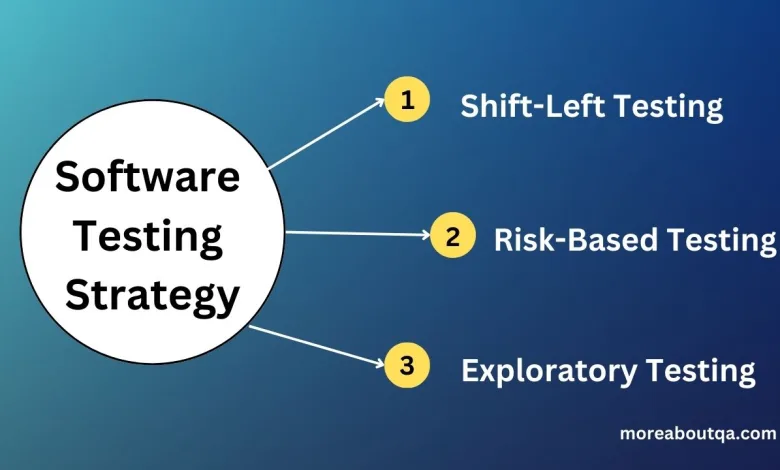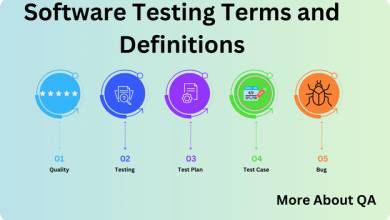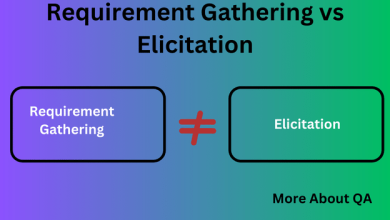
Being as a QA you mush have clear concept of the testing strategies to answer the question, “What is Test Strategy in Software Testing?”. A test strategy is a high-level plan that outlines how you’ll ensure the quality of your software throughout the development process. It’s like a roadmap that guides your testing activities, from creating test cases to reporting bugs. Different testing strategies are used to test software.
What are Top 3 Software Testing Strategies?
It depend on the context of the project , but here are three most important strategies that are widely used:
1. Shift-Left Testing
This strategy focuses testing as early as possible in the development lifecycle, rather than waiting until the later stages. This proactive approach helps identify and fix bugs early on, which can save time and money in the long run. Shift-left testing involves activities like code reviews, static code analysis, and unit testing.
2. Risk-Based Testing
This strategy focuses on testing areas of the software that are most likely to contain defects or have the highest potential impact if they fail. It involves identifying risks associated with the software, assessing the likelihood and severity of those risks, and then prioritizing testing efforts accordingly.
3. Exploratory Testing
This strategy is a more creative approach to testing where testers think outside the box and improvise test cases as they explore the software. It is useful for finding unexpected defects or uncovering usability issues that might not be identified through scripted test cases. Exploratory testing is particularly valuable in the early stages of development when the software is still evolving.
Test Strategy vs Test Plan – What is the difference?
Here’s a breakdown of the key differences between a test strategy and a test plan:
Level of Detail
- Test Strategy: High-level document that outlines the overall approach to testing for a project or organization. It focuses on “what” and “why” of testing, providing a broad vision.
- Test Plan: Detailed document that specifies the “how” of testing for a specific project. It dives deeper into the specifics of test execution.
Scope
- Test Strategy: Applies to a broader scope, encompassing the entire testing approach for an organization or project. It sets the guiding principles for all testing activities.
- Test Plan: Focuses on the testing activities for a single project. It outlines the specific testing methods and resources needed for that particular project.
Flexibility
- Test Strategy: Relatively static document that remains consistent throughout the project lifecycle. It may evolve based on major project changes but serves as a foundational document.
- Test Plan: A more dynamic document that can be adapted as the project progresses and requirements change. New features or challenges might necessitate adjustments to the testing plan.
Ownership
- Test Strategy: Typically owned by the test manager or lead and potentially influenced by senior management.
- Test Plan: Created and owned by the test lead or manager for a specific project.
Analogy
Imagine building a house. The test strategy is like the blueprint – it defines the overall approach (number of floors, layout, etc.) and remains consistent throughout construction.
The test plan is like a detailed construction plan for a specific floor – it outlines the materials, steps, and resources needed to build that particular floor, and may be adjusted as needed.
Core Elements of an Effective Test Strategy
An effective test strategy should encompass several key aspects:
Testing Goals: What do you want to achieve with testing? In this example, you might aim to ensure users can add and remove items, apply discounts, and checkout securely.
Testing Levels & Techniques: What types of testing will you perform? You might plan for sanity testing after each new feature is built, regression testing to ensure existing features aren’t broken, and usability testing to see if the shopping cart is user-friendly.
Test Case Management: How will you document and manage your test cases? You’ll likely define a format that includes details like test case ID, description, steps to perform the test, expected results, and the actual outcome (pass/fail).
Defect Management: How will you track, and report bugs found during testing? You might establish a system for logging defects with details like severity, priority, and steps to reproduce the issue.
Tools & Resources: What tools will you use to facilitate testing? This could involve bug tracking software, automation tools for repetitive tasks, or even physical devices for mobile app testing.
Roles & Responsibilities: Who is responsible for different aspects of testing? The strategy will clarify who creates test cases, executes them, reports bugs, and collaborates with developers for fixes.
What is test strategy SDLC?
Within the Software Development Life Cycle (SDLC), the test strategy serves as a pivotal document, establishing the guiding principles and comprehensive approach for software testing. It functions as a blueprint, meticulously outlining the testing objectives, methodologies, and essential resources required to deliver software that surpasses quality expectations.
Strategic Integration with the SDLC
Early Collaboration
During the initial phases of the SDLC, teams often formulate the test strategy, coinciding with the requirements gathering stage. This proactive approach ensures seamless integration of testing considerations into the development process from the outset. This proactive approach minimizes rework and delays later in the development cycle.
Alignment with Requirements
A well-crafted test strategy meticulously aligns with the project’s functional and non-functional requirements. This ensures testing activities are specifically designed to verify if the software effectively fulfills all the predetermined criteria.
Guiding Testing Activities
The strategy serves as a compass, guiding the selection of appropriate testing techniques throughout the entire SDLC. Unit testing during development ensures individual components function as intended. Integration testing verifies seamless interaction between modules, and comprehensive system testing confirms overall system functionality.
Resource Optimization
The test strategy facilitates the efficient allocation of resources for testing activities. This includes meticulously estimating the required timeframes, personnel expertise, and necessary tools to execute the comprehensive testing plan.
Proactive Risk Management
The strategy proactively identifies potential testing risks associated with the project. A highly complex system might necessitate more rigorous testing compared to a more basic application. By anticipating these risks, the team can develop mitigation strategies to address them proactively.
Enhanced Communication & Collaboration
The test strategy fosters a collaborative environment, promoting effective communication between testers, developers, project managers, and other stakeholders. A crystal-clear understanding of the testing approach ensures everyone is aligned and working towards the same overarching goals.
Assurance of Quality
Ultimately, the test strategy plays a critical role in guaranteeing the overall quality of the software. By adhering to a structured and well-defined testing approach, the team can efficiently identify and rectify defects during the early stages of development. This leads to a more robust, dependable final product.
Summary
Now you have a clear concept and you can answer the question, “What is Test Strategy in Software Testing?” A test strategy is a roadmap that guides software testing throughout development. It defines goals, techniques, and resources to ensure high-quality software by outlining how to create test cases, manage defects, and collaborate effectively.

